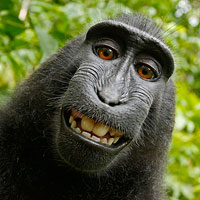US Copyright Office doesn’t want any monkey business
posted Friday, August 22, 2014 at 8:47 AM EST

Unless you've been living under a rock these last couple of weeks, you've doubtless heard the story of nature photographer David Slater vs. Wikimedia. Slater published a photo in 2011 which was picked up by news media around the world, and shortly thereafter, by Wikimedia Commons, the free, online media repository run by the American non-profit Wikimedia Foundation.
Although Wikimedia's usual policy is to self-police, disallowing copyrighted works entirely, its editors chose to retain this image, arguing that it wasn't captured by a person and hence wasn't eligible for copyright. Slater, meanwhile, acknowledged that he didn't press the shutter, but claimed that since he provided the equipment and set it up, the copyright was his own regardless of how the actual capture was triggered.
It's a difficult case, not least because Slater's story has changed significantly since the photo was first released in 2011. At the time, he minimized his own involvement and claimed its capture to be entirely accidental, telling the Daily Mail that he simply left the camera unattended and a monkey "must have accidentally knocked the camera and set it off". Now, though, he maintains that -- although the images are captured with the camera radically tilted to one side -- he'd actually set it up on a tripod with a cable release, specifically with the intention of the chimp capturing a selfie.
That's quite an important distinction, because the more involvement he had in the capture of the image in terms of setup, the easier it becomes to argue for his copyright. After all, nobody would argue that if a camera is set up to be triggered, say, by a balloon being burst, that the photographer didn't hold the copyright as they'd not personally triggered the exposure. At the same time, though, if you simply left your camera in a public place and then came back to find it filled with photos you hadn't captured, you wouldn't expect to own copyright to those images, any more than you would if you'd loaned your camera to a friend for the day.
It's a complex argument that depends very much on how you interpret copyright laws, and one that we could argue for both sides all day long. And while Slater's story has changed, it's quite possible that he's now telling the truth, and that he originally downplayed his involvement solely to better the photos' backstory and help increase their saleability.
Be that as it may, a stalemate has been reached that can only be answered by the legal system, and that's likely to take quite some time. In the meantime, though, the US Copyright Office has stepped forward to make its position known. Specifically citing a photograph taken by a monkey as an example, the government body has made clear that works not created by humans -- be they produced by nature, animals, plants, divine beings or even the supernatural -- cannot be registered as an original work in the USA. In full, the Copyright Office's stand, as taken from a public draft of the Compendium of U.S. Copyright Office Practices, Third Edition, is as follows:
The Human Authorship Requirement
The U.S. Copyright Office will register an original work of authorship, provided that the work was created by a human being.
The copyright law only protects “the fruits of intellectual labor” that “are founded in the creative powers of the mind.” Trade-Mark Cases, 100 U.S. 82, 94 (1879). Because copyright law is limited to “original intellectual conceptions of the author,” the Office will refuse to register a claim if it determines that a human being did not create the work. Burrow-Giles Lithographic Co. v. Sarony, 111 U.S. 53, 58 (1884).
The Office will not register works produced by nature, animals, or plants. Likewise, the Office cannot register a work purportedly created by divine or supernatural beings, although the Office may register a work where the application or the deposit copy(ies) state that the work was inspired by a divine spirit.
Examples:
-
A photograph taken by a monkey.
-
A mural painted by an elephant.
-
A claim based on the appearance of actual animal skin.
-
A claim based on driftwood that has been shaped and smoothed by the ocean.
-
A claim based on cut marks, defects, and other qualities found in natural stone.
There's a moral to this story, it seems. If you want to claim rights to a photo, be it of man or beast, take it your self -- don't say it's a selfie. It may get less attention that way, but it's a whole lot easier to say it's your own creation.
(via PDN Online)